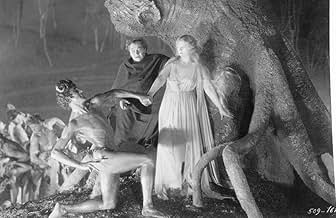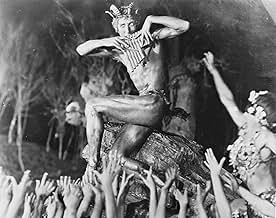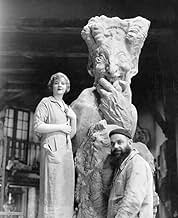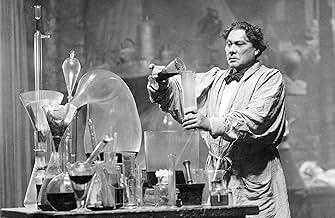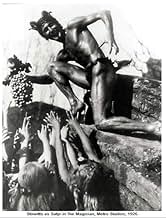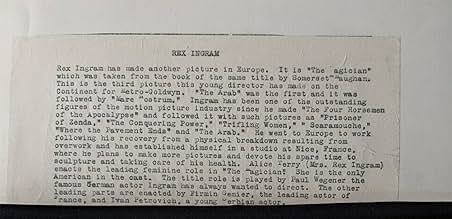A magician/alchemist, seeking to create life, finds that he needs the "blood of a virgin" to continue his experiments. He sends out his dwarf assistant to pick out the right girl.A magician/alchemist, seeking to create life, finds that he needs the "blood of a virgin" to continue his experiments. He sends out his dwarf assistant to pick out the right girl.A magician/alchemist, seeking to create life, finds that he needs the "blood of a virgin" to continue his experiments. He sends out his dwarf assistant to pick out the right girl.
Hubert I. Stowitts
- Dancing Faun
- (as Stowitts)
Claude Fielding
- Dancing Faun
- (uncredited)
Gerald Fielding
- Dancing Faun
- (uncredited)
Rosita Garcia
- Arab Girl Bitten by Snake
- (uncredited)
John George
- Haddo's Dwarf Servant
- (uncredited)
Michael Powell
- Man with Balloon at Snake Charming
- (uncredited)
- Director
- Writers
- All cast & crew
- Production, box office & more at IMDbPro
Featured reviews
Practically every element of this film holds up very well here in the twenty-first century, eighty-four years after the movie was made - the writing, the casting, the directing (and art direction), the photography (both indoor and outdoor), the "costumes" and "sets" (really, the fashions and architecture of the era were a captivating delight), and most of the acting. I say "most" because the only thing that seemed dated in this post-feminist era was the woe-is-me attitude of the hapless heroine.
Particularly well-cast in terms of "looking the part" were the two male leads, both protagonist and antagonist. (After all, these were not speaking parts, so look was of high importance.)
Surprisingly enjoyable were some quite subtle, non-intrusive comedic tension-breakers by peripheral characters, including some clever silent movie sight gags.
The main recommendation I can make for seeing this film, however, is the clarity of the photography, both for the close-ups, and for some wonderful outdoor set pieces.
Particularly well-cast in terms of "looking the part" were the two male leads, both protagonist and antagonist. (After all, these were not speaking parts, so look was of high importance.)
Surprisingly enjoyable were some quite subtle, non-intrusive comedic tension-breakers by peripheral characters, including some clever silent movie sight gags.
The main recommendation I can make for seeing this film, however, is the clarity of the photography, both for the close-ups, and for some wonderful outdoor set pieces.
In Paris, beautiful sculptress Alice Terry (as Margaret Dauncey) is critically wounded when a giant faun she is working on cracks, topples, and crushes her body. Ms. Terry's wealthy uncle summons American surgeon Ivan Petrovich (as Arthur Burdon) to operate on Terry's paralyzed body. The doctor and patient celebrate Terry's full recovery by falling in love. During their courtship, they encounter magician hypnotist Paul Wegener (as Oliver Haddo), an alchemist who witnessed Terry's miraculous surgery. A frightening, rotund man, Mr. Wegener happens to encounter Dr. Petrovich and Terry again and again. Wegener wants to create life, and has decided Terry will supply the "Blood of a Maiden" required in an ancient sorcerer's recipe!
While still a young woman, Terry seems more like a matron than a maiden - guess you just have to assume "The Magician" knows a virgin when he sees one. In W. Somerset Maugham's original novel, the Terry character is a teenaged art student, and the intriguing Gladys Hamer (as Susie Boyd) an older rival; it's an excellent read, and fairly easy to find on line (for free). Most unclear, in the film, is exactly how Wegener's experiment is supposed to work. Playing "Dr. Frankenstein" (and inspiring the 1931 classic's design), Wegener sets up a lab to extract blood, apparently. Highlighted by a hellish hallucination, it's very nicely envisioned by Terry's skillful director husband Rex Ingram; but, it lacks the richness of plot abundantly available in the book.
****** The Magician (10/24/26) Rex Ingram ~ Alice Terry, Paul Wegener, Ivan Petrovich, Firmin Gemier
While still a young woman, Terry seems more like a matron than a maiden - guess you just have to assume "The Magician" knows a virgin when he sees one. In W. Somerset Maugham's original novel, the Terry character is a teenaged art student, and the intriguing Gladys Hamer (as Susie Boyd) an older rival; it's an excellent read, and fairly easy to find on line (for free). Most unclear, in the film, is exactly how Wegener's experiment is supposed to work. Playing "Dr. Frankenstein" (and inspiring the 1931 classic's design), Wegener sets up a lab to extract blood, apparently. Highlighted by a hellish hallucination, it's very nicely envisioned by Terry's skillful director husband Rex Ingram; but, it lacks the richness of plot abundantly available in the book.
****** The Magician (10/24/26) Rex Ingram ~ Alice Terry, Paul Wegener, Ivan Petrovich, Firmin Gemier
In the 1920s films dealing with supernatural evil were extremely rare. However, director Rex Ingram, obviously influenced by earlier German forays into the supernatural, cast German actor Paul Wegener of DER GOLEM in this adaptation of Somerset Maugham's novel THE MAGICIAN. Wegener's menacing performance as an evil Yogi in LEBENDE BUDDHAS (1925) made him a good choice to play Oliver Haddo, obsessed with creating life from an ancient formula requiring the heart's blood of a maiden, played by Ingram's wife Alice Terry.
John F. Seitz' cinematography is superb, especially in the depiction of the heroine's hallucinatory descent into Hell where she is figuratively ravished by a lustful and athletic satyr. And although Haddo doesn't succeed in creating the grisly, half-complete humans as in the novel, the controversial subject matter was nevertheless strong enough to insure the film's failure at the box-office in 1926.
Interesting comparisons have been made between this film and James Wale's FRANKENSTEIN, but the subject of black magic also invites comparison with later films - THE BLACK CAT (1934), THE NIGHT OF THE DEMON (1957), and THE DEVIL RIDES OUT (1968) - featuring characters who like Oliver Haddo were modeled on real-life occultist Aleister Crowley.
John F. Seitz' cinematography is superb, especially in the depiction of the heroine's hallucinatory descent into Hell where she is figuratively ravished by a lustful and athletic satyr. And although Haddo doesn't succeed in creating the grisly, half-complete humans as in the novel, the controversial subject matter was nevertheless strong enough to insure the film's failure at the box-office in 1926.
Interesting comparisons have been made between this film and James Wale's FRANKENSTEIN, but the subject of black magic also invites comparison with later films - THE BLACK CAT (1934), THE NIGHT OF THE DEMON (1957), and THE DEVIL RIDES OUT (1968) - featuring characters who like Oliver Haddo were modeled on real-life occultist Aleister Crowley.
Its all here in embryo: the paradigm for Frankenstein. The mad scientist, trying to create life in his laboratory located in a forbidden tower on the top of a rocky mountain, while thunder and lightning terrify the superstitious villagers. Supposedly adapted from a W. Somerset Maugham novel, the possibility exists that it was Maugham (a qualified physician) who, still very much on the make for an overwhelming success in his third book, might have cribbed more than a little bit from Mary Shelly. However, instead of the Romantic Prometheus, driven mad by hubris and symbolic of mankind's desire to harness newfangled science to dominate and conquer nature, despite the warnings of terrible consequences, all taking place on the edge of the Industrial revolution, we have the elements shaped into a Victorian melodrama of the villain-continued-to-pursue-her variety complete with virgin's blood and a heroine tied in artful knots, and a villain motivated by nothing more than criminal insanity.
On the other hand the artful visual qualities of the storytelling is something that has been lost in today's film vocabulary. A zippy 80 minutes or so, today the coarse need for thrills from this type of film would have necessitated a number anatomically gruesome murders before the final heroine jeopardy and heroic rescue. Here a little horror goes a very long way (all the way to the French Riviera, in fact). THE MAGICIAN is everything that made the silent film, at the same time, so great and so very silly. By the way, shots of Paris, virtually traffic free are a revelation, as are shots of a cobblestone village high up in the mountains (the Alps Maritimes) behind the Riviera. And yes, that's the same Paul Wegener who directed and starred in two versions of The Golom as well as playing Svengali in a 1927 version of the Du Maurier story.
On the other hand the artful visual qualities of the storytelling is something that has been lost in today's film vocabulary. A zippy 80 minutes or so, today the coarse need for thrills from this type of film would have necessitated a number anatomically gruesome murders before the final heroine jeopardy and heroic rescue. Here a little horror goes a very long way (all the way to the French Riviera, in fact). THE MAGICIAN is everything that made the silent film, at the same time, so great and so very silly. By the way, shots of Paris, virtually traffic free are a revelation, as are shots of a cobblestone village high up in the mountains (the Alps Maritimes) behind the Riviera. And yes, that's the same Paul Wegener who directed and starred in two versions of The Golom as well as playing Svengali in a 1927 version of the Du Maurier story.
Beautiful Margaret Dauncey (Alice Terry) is set to marry young handsome Dr. Arthur Burdon (Ivan Petrovich). They meet an evil magician named Oliver Haddo (Paul Wegener) who is trying to create life. He needs the blood of someone whose profile fits Margaret's perfectly...and he'll so ANYTHING to get it.
Hard to see silent. I want to thank TCM for showing it about a week ago. The print was in pretty good shape with tinting and an amusing music score (LOVED when they used "Night on Bald Mountain"). The movie was made with a pretty big budget--the settings are incredible--and has a good script that follows many horror film clichés--but in a good way. Heck, it all ends on a dark and stormy night and in a CASTLE! Also there's a trip to Hell which is a real jaw dropper. The acting varies. Terry was a star of the silent screen and it's easy to see why. She was a beautiful woman AND a good actress. She's just great here. Wegener chews the scenery again and again and AGAIN as the mad magician. He really overdoes it--but it's pretty amusing. Petrovich is given nothing to do as the doctor but him and Terry make a very good-looking couple. Beautifully directed by Rex Ingram too (who was Terry's husband). Well worth seeing--if you can.
Hard to see silent. I want to thank TCM for showing it about a week ago. The print was in pretty good shape with tinting and an amusing music score (LOVED when they used "Night on Bald Mountain"). The movie was made with a pretty big budget--the settings are incredible--and has a good script that follows many horror film clichés--but in a good way. Heck, it all ends on a dark and stormy night and in a CASTLE! Also there's a trip to Hell which is a real jaw dropper. The acting varies. Terry was a star of the silent screen and it's easy to see why. She was a beautiful woman AND a good actress. She's just great here. Wegener chews the scenery again and again and AGAIN as the mad magician. He really overdoes it--but it's pretty amusing. Petrovich is given nothing to do as the doctor but him and Terry make a very good-looking couple. Beautifully directed by Rex Ingram too (who was Terry's husband). Well worth seeing--if you can.
Did you know
- TriviaThis movie, especially the explosion of the laboratory, influenced James Whale while making the Frankenstein (1931) movies.
- Quotes
Dr. Arthur Burdon: Your niece is certainly the most beautiful patient I have ever had.
Details
- Runtime
- 1h 23m(83 min)
- Sound mix
- Aspect ratio
- 1.33 : 1
Contribute to this page
Suggest an edit or add missing content

